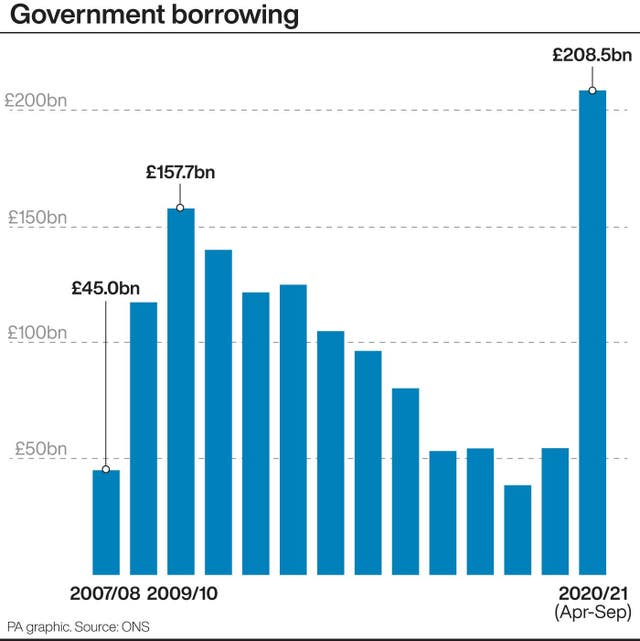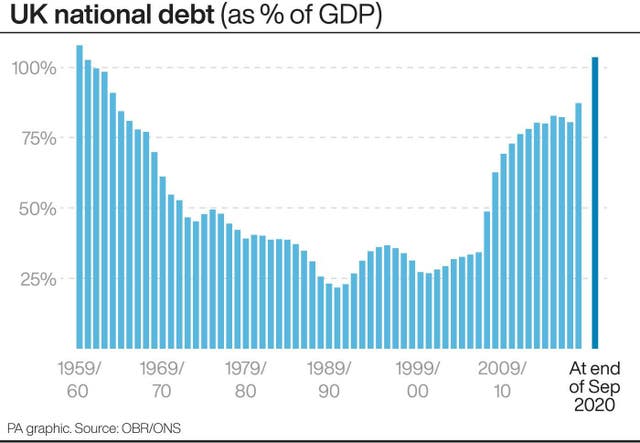
Iain Dale 10am - 1pm
21 October 2020, 13:24

The latest ONS stats show the public sector borrowed £36.1 billion in September.
The UK’s national debt hit a record £2.06 trillion at the end of September, up £259.6 billion in six months, according to new data from the Office for National Statistics (ONS).
It pushed borrowing up to 103.5% of gross domestic product (GDP) after the public sector borrowed around £36.1 billion in September – pushing the debt to GDP ratio to the highest levels since 1960.
This was £28.4 billion more than the same month a year ago and the third-highest month of borrowing since records began in 1993, officials added.

At the end of September there was £1.741 trillion of central government bonds, or gilts, in circulation to prop up the falling tax take and cover the huge expenditure related to Covid-19 spending.
Central government tax receipts were £37.7 billion in September – £6 billion less than in September 2019, with large falls in value added tax (VAT), business rates and corporation tax receipts, the ONS added.
The Government is expected to have spent £77.8 billion in September on day-to-day activities – £18.1 billion more than in September 2019 – including £4.9 billion on the furlough scheme and £1 billion on the self-employment support scheme payouts.
Borrowing in the first six months of this financial year – April to September – is estimated at £208.5 billion, £174.5 billion more than in the same period last year and the highest borrowing in any April to September period since records began in 1993. Each and every month set a new record, the ONS added.
Today’s @ONS figures show government borrowing exceeded £208bn between April and September 2020.
This compares to £31bn in the same period last year and is more than in any year on record. But it is £54bn, or one-fifth, less than the @OBR_uk ’s ‘central’ scenario projection. pic.twitter.com/5hDvf990sx
— Institute for Fiscal Studies (@TheIFS) October 21, 2020
Chancellor of the Exchequer, Rishi Sunak, said: “Whilst it’s clear that the coronavirus pandemic has had a significant impact on our public finances, things would have been far worse had we not acted in the way we did to protect millions of livelihoods.
“I’ve been clear that our enduring priority is to protect as many jobs and businesses as possible through this pandemic, which is the fiscally responsible thing to do.
“Through our comprehensive Plan for Jobs we’re protecting, supporting and creating millions of jobs across the country.
“Over time and as the economy recovers, the Government will take the necessary steps to ensure the long-term health of the public finances.”
Economists and commentators said the news was not as bad as first thought but warned that a significant second wave could have further damaging effects.

Alison Ring, director at the Institute of Chartered Accountants in England and Wales, said: “The economic damage caused by the pandemic in the first half of the fiscal year was not as bad as originally feared, thanks in part to the extraordinary level of financial support provided by the Chancellor.
“However, the second wave is putting further strain on the public finances as new regional restrictions are placed on economic activity.”
Yael Selfin, chief economist at KPMG UK, said: “The combination of low inflation and stretched public finances could mean a difficult autumn for businesses affected by renewed Covid restrictions, reduced government support and weak inflation keeping the value of real wages higher than expected.”
And Samuel Tombs, chief UK economist at Pantheon Macroeconomics, pointed out that the cost of the Job Retention Scheme and the Self-Employment Income Support Scheme were slightly lower than the Office for Budget Responsibility (OBR) forecasts.
He added: “Expenditure will pick-up if Tier 3 restrictions are imposed in more regions, as hospitality businesses that are forced to close in these areas will be able to furlough staff with state support again.
“In the round then, the OBR’s forecast for public borrowing of £372 billion — probably close to 16% of GDP — still looks about right.”